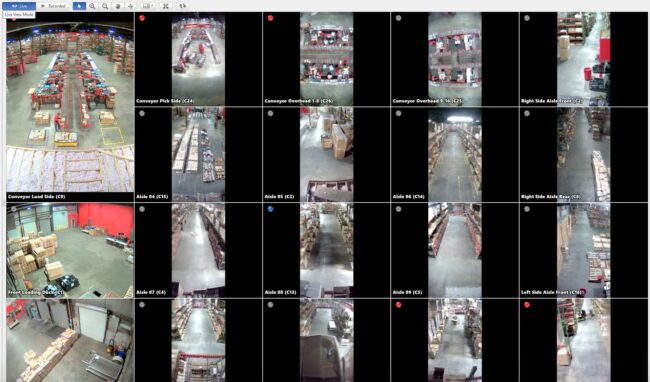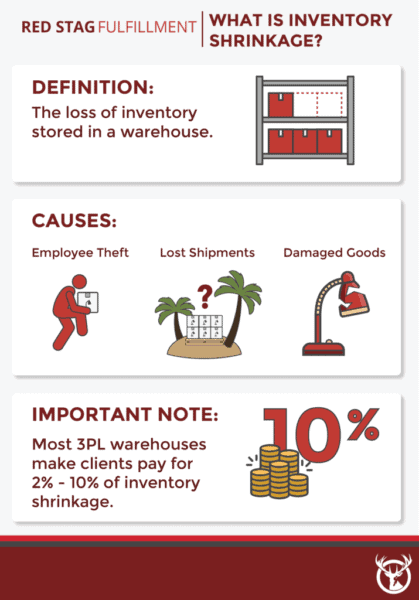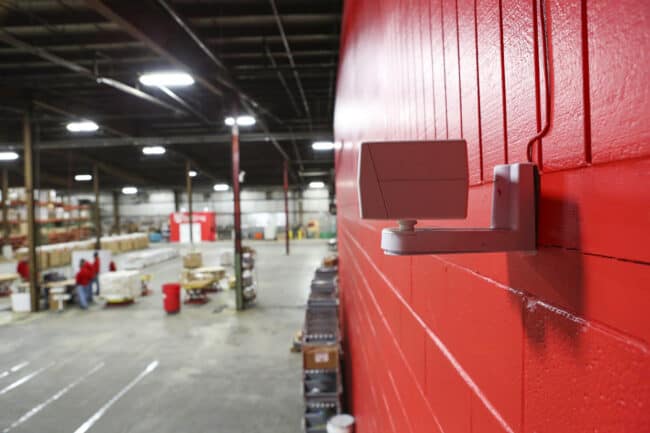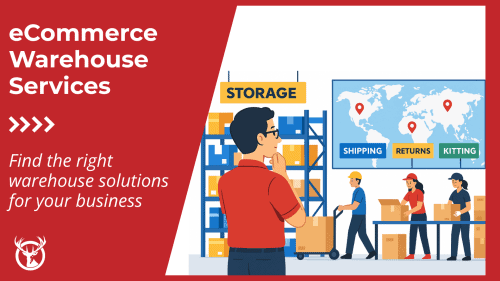Every lost or damaged product ticks your shrinkage rate higher and makes it harder to turn a profit. While some amount of shrinkage may feel unavoidable, it’s worth doing what you can to stem these losses. In the eCommerce world, that usually means protecting goods in your warehouse or finding the right fulfillment partner with world-class security measures.
Red Stag Fulfillment focuses on eliminating warehouse shrinkage every day. We protect client inventory by verifying orders during multiple steps, offering 24/7 security monitoring, and giving you a zero-shrinkage promise.
Not sure if your business should take shrinkage seriously? Let’s look at the numbers to see what they might mean for you.
What does shrinkage include?
- Theft of products by employees or a partner’s employees
- Lost shipments that go missing in transit, requiring time and effort to file claims and recoup partial losses
- Waste and spoilage of perishable goods going bad before being sold
- Damage to products during the receiving, storage, and picking phases
- Misplacing goods within a warehouse, staging area, or on the wrong shelf/bin causes them to be overlooked and removed from inventory cycle counts
- Returns where products are shipped back incomplete or damaged, by the customer or during transit
- Supplier mistakes or fraud where inbound freight doesn’t match order counts
All these types of shrinkage impact your shrinkage rate. That’s calculated by looking at the inventory you should have on hand (based on current stock and inbound freight), subtracting the actual amount of inventory available on warehouse shelves, and dividing by the inventory you should have.
For example, you’ve ordered 100 units, and that shipment has been received and recorded as being on your shelves. But, when pickers go to those shelves, just 95 units are physically there. Take the 100 you’re supposed to have, subtract the 95 you do have, and then divide the remaining 5 by the original 100.
This would give you a shrinkage rate of 5%. Your business must pay at least an additional 5% on inventory to make the same amount of revenue it should get from those first 100 units.
$61.7 billion lost in 2019
U.S. retail shrinkage hit an all-time high in 2019, costing American businesses $61.7 billion, or 1.62% of a retailer’s bottom line. That’s according to the National Retail Federation’s 2020 National Retail Security Survey, which also found more than 70% of retailers had a shrinkage rate higher than 1%. And 18.2% of U.S. sellers had shrinkage rates higher than 3%.
Nearly 60% of all retailers say eCommerce crimes were “somewhat more” or “much more” of a priority, and the NRF expects that to rise in its upcoming report looking at 2020. That’s troubling because only one-quarter of retailers and eCommerce companies are putting more staff toward this rising threat. More than 63% of all sellers say they either maintained or reduced the budget they could put toward fighting shrinkage.
That means your partners’ efforts and guarantees are more important than ever for controlling shrinkage and protecting your bottom line.
Business impacts of shrinkage
You know shrinkage is terrible and that it impacts your ability to operate. Looking a little deeper points out a few other impacts of shrinkage that could mean that it’s eroding your bottom line more than you think.
Reduced revenue
Shrinkage often focuses on profit, but it’s important to remember that it reduces total revenue too. The one-two punch is that having fewer products to sell reduces your total revenue potential, but you’ve got to spend more to address the other aspects of shrinkage.
Replacement costs
You must replace lost products to meet your order projections. That means increase expenses for purchasing goods, shipping them to your locations, and more.
Increased labor costs
When shrinkage happens, you replace those goods. Then, your warehouse has more labor for intaking this inventory, putting it on shelves, and using it in orders. High shrinkage levels often lead to more inventory counts and verification, which adds more work for multiple teams that may already be stretched thin.
Added security costs
When shrinkage is a significant issue, many companies need to hire security personnel or add security training for management. You may also need to install 24/7 camera systems and alarm systems to reduce theft as well.
Added technology costs
In the eCommerce space, shrinkage intersects with most of your technology. To combat product losses, you may need to invest in more scanning devices and a more expensive but robust inventory management system. That’ll control how goods move and add steps to each warehouse process. Not only do you have to pay for more hardware and software, but teams need time to learn the tools and then additional time to use them during tasks.
Also in the software bucket are potential losses due to customer theft using codes, discounts, and other deals beyond expiration dates. People share discount codes online, and your business might not be prepared for everyone to save 50% when you just sent that code out to the most loyal fans.
Leadership’s time and attention
Shrinkage takes the focus at all levels of your company. Instead of trying to grow the business, leadership must spend time on stopping the bleeding. People outside of product and warehouse operations get involved, too, such as financial professionals reconciling losses for your ability to pay vendors or even file your taxes.
Reduced morale
All the concerns above may culminate in a workplace that doesn’t feel like it trusts or prioritizes your team members. New security measures can feel overbearing and distress your best staff. Letting shrinkage get bad enough to become a core focus can make it difficult for leaders to retain employees and protect business operations.
Is shrinkage harming your customers?
A typical response to shrinkage is to raise prices to make up for the revenue losses and increased costs. Many need it to keep their operations running, allowing them to grow. Unfortunately, that could mean you’re pushing prices too high for some of your customers. If you’re competing on margins or have a price-sensitive audience, high shrinkage rates could push your pricing too high.
When allowed to flourish, shrinkage harms your ability to generate revenue today and can easily lower your ceiling in the next quarter and beyond.
Your 3PL must pay attention to shrinkage
Trust is a necessity when you outsource fulfillment. When someone is losing or damaging your products, they harm trust and your business. That’s not how it should be.
At Red Stag Fulfillment, we have a zero-shrinkage guarantee because we believe that safely warehousing your products is part of our job. If we lose or damage one of your products, we compensate you for the wholesale cost. That sets us apart from the industry standard, where 3PLs will have you pay between 2% and 10% of inventory shrinkage.
We think zero shrinkage is a feasible goal for any eCommerce business. Our clients deserve that guarantee. It’s just that simple. If your 3PL asks you to pay for products that they lose or damage, it might be time to test a new partner.
Ask yourself this, what would you do if you turned a 5% shrinkage rate to 0%?

















